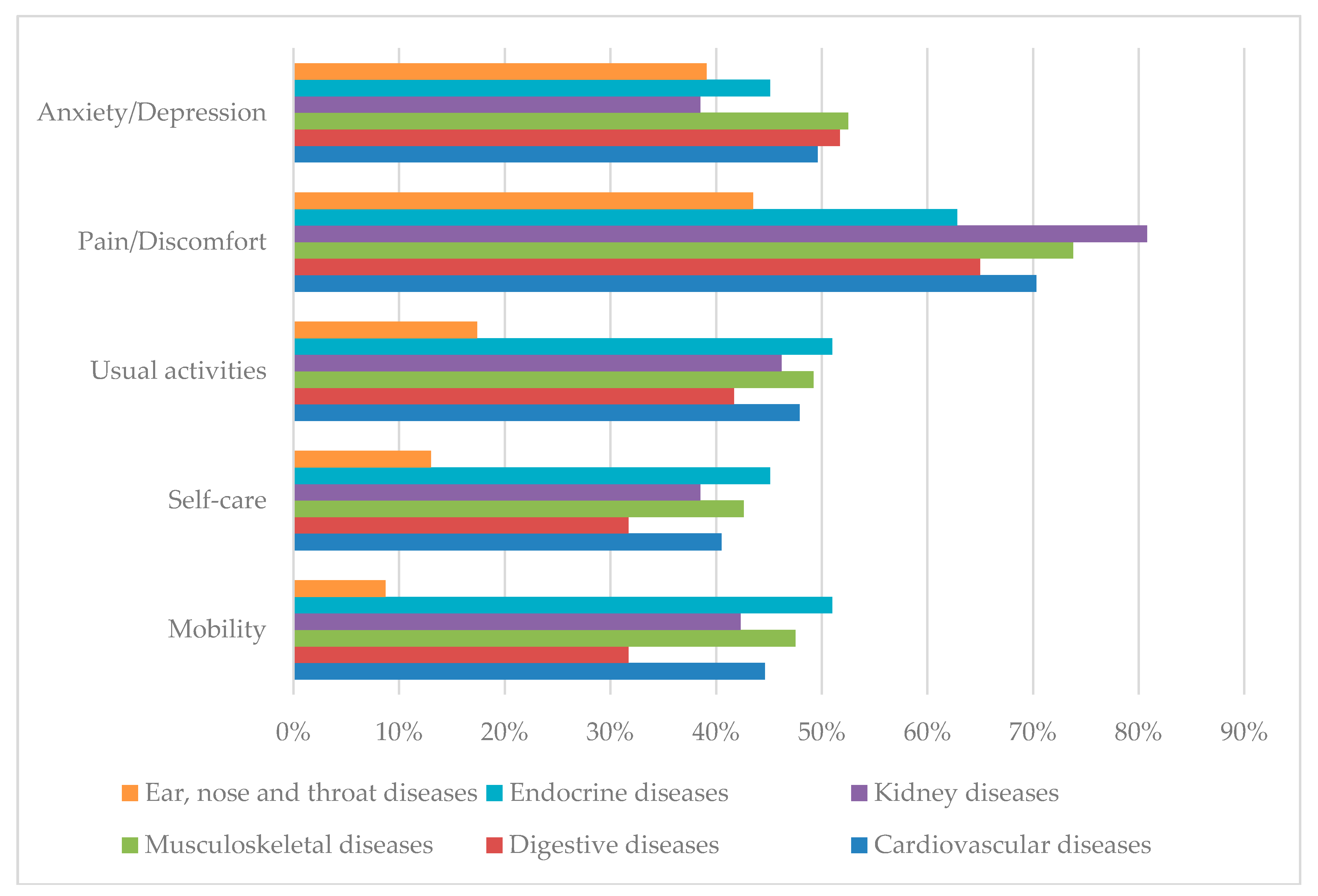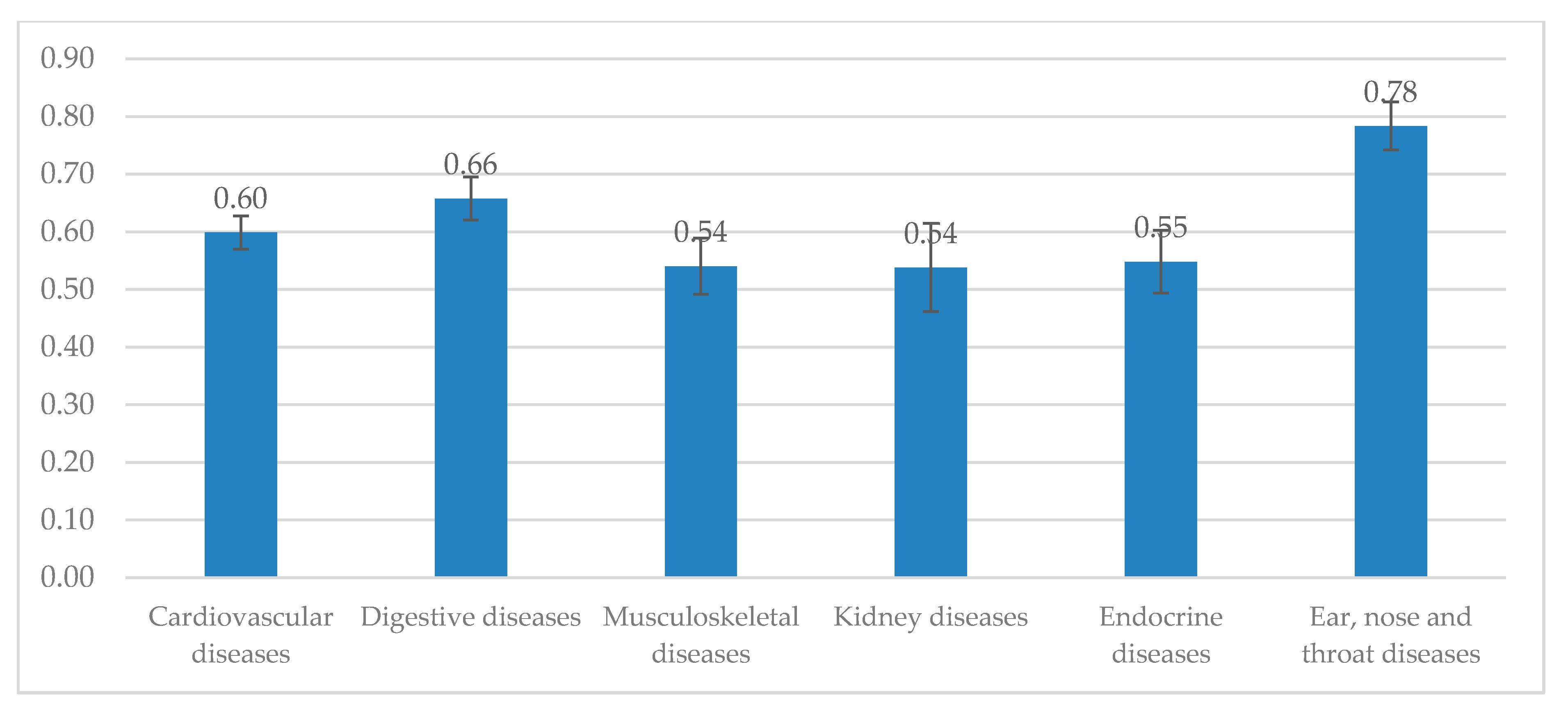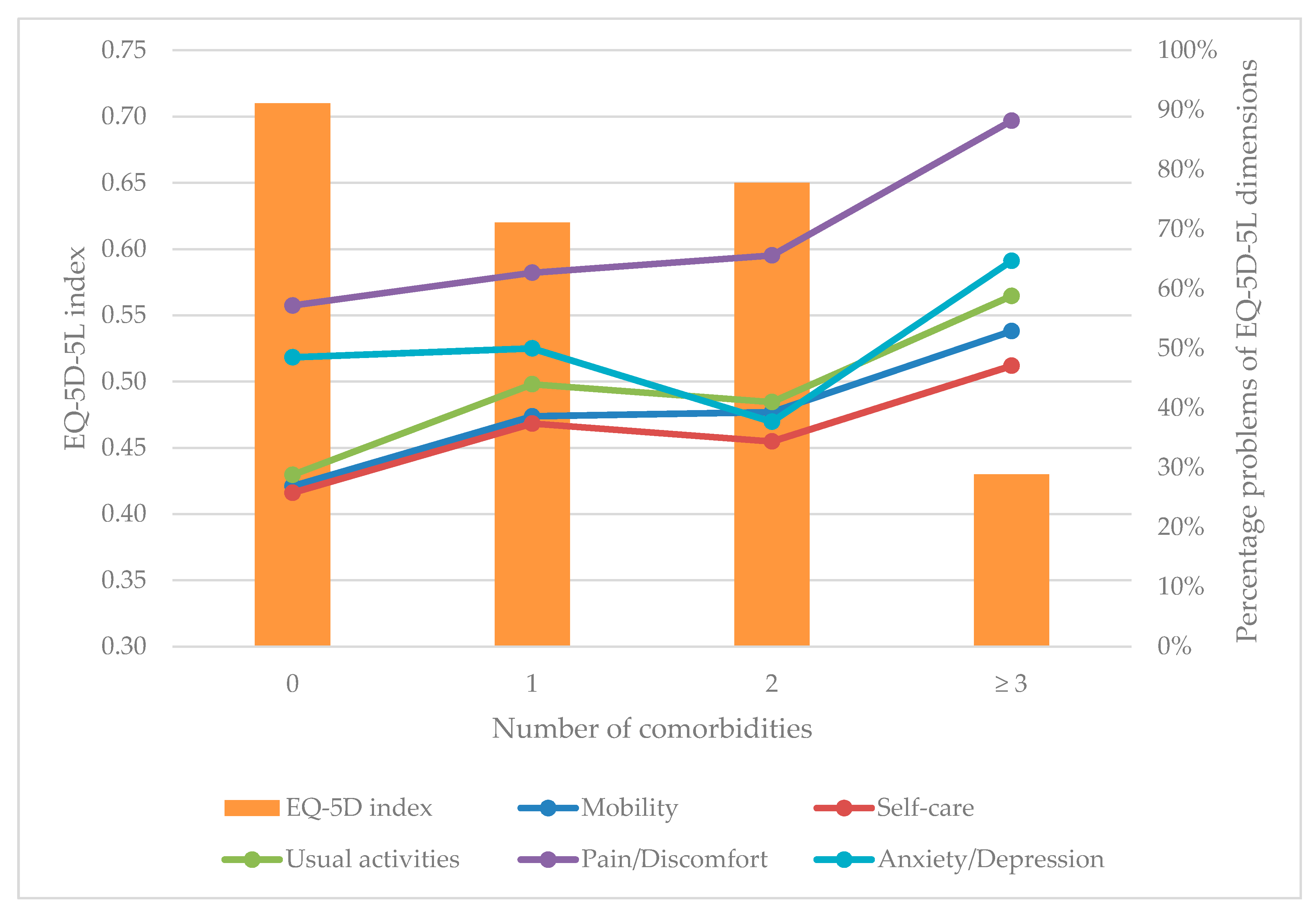Effects of Different Comorbidities on Health-Related Quality of Life among Respiratory Patients in Vietnam
Abstract
:1. Introduction
2. Experimental Section
2.1. Study Design and Sampling
2.2. Measurements and Instruments
2.2.1. Socio-Economic Characteristic
2.2.2. Health-Related Quality of Life (HRQOL) and Comorbidities
2.3. Statistical Analysis
3. Results
4. Discussion
5. Conclusions
Author Contributions
Funding
Acknowledgments
Conflicts of Interest
References
- World Health Organization. Chronic Respiratory Diseases. 2017. Available online: https://www.who.int/respiratory/en/ (accessed on 12 December 2018).
- Rabe, K.F.; Hurd, S.; Anzueto, A.; Barnes, P.J.; Buist, S.A.; Calverley, P.; Fukuchi, Y.; Jenkins, C.; Rodriguez-Roisin, R.; van Weel, C.; et al. Global strategy for the diagnosis, management, and prevention of chronic obstructive pulmonary disease: GOLD executive summary. Am. J. Respir. Crit. Care Med. 2007, 176, 532–555. [Google Scholar] [CrossRef] [PubMed]
- Cazzola, M.; MacNee, W.; Martinez, F.J.; Rabe, K.F.; Franciosi, L.G.; Barnes, P.J.; Brusasco, V.; Burge, P.S.; Calverley, P.M.; Celli, B.R.; et al. Outcomes for COPD pharmacological trials: From lung function to biomarkers. Eur. Respir. J. 2008, 31, 416–469. [Google Scholar] [CrossRef] [PubMed]
- Burgel, P.R.; Escamilla, R.; Perez, T.; Carre, P.; Caillaud, D.; Chanez, P.; Pinet, C.; Jebrak, G.; Brinchault, G.; Court-Fortune, I.; et al. Impact of comorbidities on COPD-specific health-related quality of life. Respir. Med. 2013, 107, 233–241. [Google Scholar] [CrossRef] [PubMed]
- Koskela, J.; Kilpelainen, M.; Kupiainen, H.; Mazur, W.; Sintonen, H.; Boezen, M.; Lindqvist, A.; Postma, D.; Laitinen, T. Co-morbidities are the key nominators of the health related quality of life in mild and moderate COPD. BMC Pulm. Med. 2014, 14, 102. [Google Scholar] [CrossRef] [PubMed]
- Hossny, E.; Caraballo, L.; Casale, T.; El-Gamal, Y.; Rosenwasser, L. Severe asthma and quality of life. World Allergy Organ. J. 2017, 10, 28. [Google Scholar] [CrossRef] [PubMed]
- Yohannes, A.M. The Impact of Comorbidities in Patients with Chronic Respiratory Diseases. In Depression and Anxiety in Patients with Chronic Respiratory Diseases; Sharafkhaneh, A., Yohannes, A.M., Hanania, N.A., Kunik, M.E., Eds.; Springer: New York, NY, USA, 2017; pp. 129–148. [Google Scholar]
- Su, X.; Ren, Y.; Li, M.; Zhao, X.; Kong, L.; Kang, J. Prevalence of Comorbidities in Asthma and Nonasthma Patients: A meta-analysis. Medicine 2016, 95, e3459. [Google Scholar] [CrossRef] [PubMed]
- Yin, H.L.; Yin, S.Q.; Lin, Q.Y.; Xu, Y.; Xu, H.W.; Liu, T. Prevalence of comorbidities in chronic obstructive pulmonary disease patients: A meta-analysis. Medicine 2017, 96, e6836. [Google Scholar] [CrossRef]
- Antonelli Incalzi, R.; Fuso, L.; De Rosa, M.; Forastiere, F.; Rapiti, E.; Nardecchia, B.; Pistelli, R. Co-morbidity contributes to predict mortality of patients with chronic obstructive pulmonary disease. Eur. Respir. J. 1997, 10, 2794–2800. [Google Scholar] [CrossRef]
- Almagro, P.; Cabrera, F.J.; Diez, J.; Boixeda, R.; Alonso Ortiz, M.B.; Murio, C.; Soriano, J.B. Comorbidities and short-term prognosis in patients hospitalized for acute exacerbation of COPD: The EPOC en Servicios de medicina interna (ESMI) study. Chest 2012, 142, 1126–1133. [Google Scholar] [CrossRef]
- Janson, C.; Marks, G.; Buist, S.; Gnatiuc, L.; Gislason, T.; McBurnie, M.A.; Nielsen, R.; Studnicka, M.; Toelle, B.; Benediktsdottir, B.; et al. The impact of COPD on health status: Findings from the BOLD study. Eur. Respir. J. 2013, 42, 1472–1483. [Google Scholar] [CrossRef]
- Charlson, M.; Charlson, R.E.; Briggs, W.; Hollenberg, J. Can disease management target patients most likely to generate high costs? The impact of comorbidity. J. Gen. Intern. Med. 2007, 22, 464–469. [Google Scholar] [CrossRef] [PubMed]
- Wijnhoven, H.A.; Kriegsman, D.M.; Hesselink, A.E.; de Haan, M.; Schellevis, F.G. The influence of co-morbidity on health-related quality of life in asthma and COPD patients. Respir. Med. 2003, 97, 468–475. [Google Scholar] [CrossRef] [PubMed]
- Katsura, H.; Yamada, K.; Kida, K. Both generic and disease specific health-related quality of life are deteriorated in patients with underweight COPD. Respir. Med. 2005, 99, 624–630. [Google Scholar] [CrossRef] [PubMed]
- Sundh, J.; Stallberg, B.; Lisspers, K.; Montgomery, S.M.; Janson, C. Co-morbidity, body mass index and quality of life in COPD using the Clinical COPD Questionnaire. COPD 2011, 8, 173–181. [Google Scholar] [CrossRef] [PubMed]
- Hays, R.D.; Woolley, J.M. The concept of clinically meaningful difference in health-related quality-of-life research. How meaningful is it? PharmacoEconomics 2000, 18, 419–423. [Google Scholar] [CrossRef] [PubMed]
- Chen, P.; Lin, K.C.; Liing, R.J.; Wu, C.Y.; Chen, C.L.; Chang, K.C. Validity, responsiveness, and minimal clinically important difference of EQ-5D-5L in stroke patients undergoing rehabilitation. Qual. Life Res. 2016, 25, 1585–1596. [Google Scholar] [CrossRef] [PubMed]
- CDC Vietnam. Top 10 Cause of Death 2015. Available online: https://www.cdc.gov/globalhealth/countries/vietnam/ (accessed on 12 December 2018).
- Nguyen, L.H.; Tran, B.X.; Hoang Le, Q.N.; Tran, T.T.; Latkin, C.A. Quality of life profile of general Vietnamese population using EQ-5D-5L. Health Qual. Life Outcomes 2017, 15, 199. [Google Scholar] [CrossRef]
- Shiroiwa, T.; Fukuda, T.; Ikeda, S.; Igarashi, A.; Noto, S.; Saito, S.; Shimozuma, K. Japanese population norms for preference-based measures: EQ-5D-3L, EQ-5D-5L, and SF-6D. Qual. Life Res. 2016, 25, 707–719. [Google Scholar] [CrossRef]
- Agborsangaya, C.B.; Lau, D.; Lahtinen, M.; Cooke, T.; Johnson, J.A. Health-related quality of life and healthcare utilization in multimorbidity: results of a cross-sectional survey. Qual. Life Res. 2013, 22, 791–799. [Google Scholar] [CrossRef]
- Seymour, J.M.; Spruit, M.A.; Hopkinson, N.S.; Natanek, S.A.; Man, W.D.; Jackson, A.; Gosker, H.R.; Schols, A.M.; Moxham, J.; Polkey, M.I.; et al. The prevalence of quadriceps weakness in COPD and the relationship with disease severity. Eur. Respir. J. 2010, 36, 81–88. [Google Scholar] [CrossRef]
- Patel, A.R.; Hurst, J.R. Extrapulmonary comorbidities in chronic obstructive pulmonary disease: State of the art. Expert Rev Respir. Med. 2011, 5, 647–662. [Google Scholar] [CrossRef] [PubMed]
- Swallow, E.B.; Reyes, D.; Hopkinson, N.S.; Man, W.D.; Porcher, R.; Cetti, E.J.; Moore, A.J.; Moxham, J.; Polkey, M.I. Quadriceps strength predicts mortality in patients with moderate to severe chronic obstructive pulmonary disease. Thorax 2007, 62, 115–120. [Google Scholar] [CrossRef] [PubMed]
- Eton, D.T.; Cella, D.; Yost, K.J.; Yount, S.E.; Peterman, A.H.; Neuberg, D.S.; Sledge, G.W.; Wood, W.C. A combination of distribution—And anchor-based approaches determined minimally important differences (MIDs) for four endpoints in a breast cancer scale. J. Clin. Epidemiol. 2004, 57, 898–910. [Google Scholar] [CrossRef] [PubMed]
- Fortin, M.; Bravo, G.; Hudon, C.; Lapointe, L.; Almirall, J.; Dubois, M.F.; Vanasse, A. Relationship between multimorbidity and health-related quality of life of patients in primary care. Qual. Life Res. 2006, 15, 83–91. [Google Scholar] [CrossRef] [PubMed]



| Characteristics | n | % |
|---|---|---|
| Gender, Male | 289 | 56.9 |
| Education | ||
| Under high school | 280 | 55.1 |
| High school | 127 | 25.0 |
| Above high school | 101 | 19.9 |
| Marital status | ||
| Married | 425 | 83.7 |
| Single | 83 | 16.3 |
| Employment | ||
| Farmers | 173 | 34.1 |
| Unemployed | 173 | 34.1 |
| Freelancers | 73 | 14.4 |
| Workers in public organizations | 43 | 8.5 |
| Workers in private organizations | 28 | 5.5 |
| Others | 18 | 3.5 |
| Living area | ||
| Urban | 174 | 34.3 |
| Rural | 334 | 65.8 |
| Mean | SD | |
| Age | 54.6 | 17.5 |
| Characteristics | n | % |
|---|---|---|
| Comorbidities | ||
| Cardiovascular diseases | 121 | 23.8 |
| Musculoskeletal diseases | 61 | 12.0 |
| Digestive diseases | 60 | 11.8 |
| Endocrine diseases | 51 | 10.0 |
| Kidney diseases | 26 | 5.1 |
| Ear, nose and throat diseases | 23 | 4.5 |
| EQ-5D-5L dimensions | ||
| Pain/Discomfort | 310 | 61.0 |
| Anxiety/Depression | 245 | 48.2 |
| Having problems with usual activity | 184 | 36.2 |
| Having problems in mobility | 168 | 33.1 |
| Having problems in self-care | 159 | 31.3 |
| Number of comorbidities | ||
| 0 | 264 | 52.0 |
| 1 | 166 | 32.7 |
| 2 | 61 | 12.0 |
| ≥3 | 17 | 3.3 |
| Mean | SD | |
| Number of comorbidities | 0.7 | 0.8 |
| EQ-5D index | 0.66 | 0.31 |
| Health Issue | n | EQ-5D Index Score | |
|---|---|---|---|
| Diff † | 95% CI | ||
| Comorbidities | |||
| No comorbidities | 264 | - | |
| Cardiovascular diseases | 121 | −0.09 * | −0.15; −0.02 |
| Musculoskeletal diseases | 61 | −0.14 * | −0.22; −0.06 |
| Digestive diseases | 60 | −0.01 | −0.09; 0.08 |
| Endocrine diseases | 51 | −0.13 * | −0.22; −0.04 |
| Kidney diseases | 26 | −0.13 * | −0.26; −0.01 |
| Ear, nose and throat diseases | 23 | 0.12 | −0.01; 0.25 |
| Number of comorbidities | |||
| 0 | 264 | - | |
| 1 | 166 | −0.10 * | −0.17; −0.02 |
| 2 | 61 | −0.07 | −0.18; 0.05 |
| ≥ 3 | 17 | −0.28 * | −0.48; −0.09 |
| Characteristics | Model 1 | Model 2 |
|---|---|---|
| Coef (95% CI) a | Coef (95% CI) b | |
| Comorbidities | ||
| Cardiovascular diseases | −0.11 (−0.19; −0.02) * | −0.06 (−0.14; 0.03) |
| Digestive diseases | −0.01 (−0.12; 0.10) | −0.01 (−0.12; 0.10) |
| Musculoskeletal diseases | −0.17 (−0.28; −0.06) * | −0.13 (−0.23; −0.02) * |
| Kidney diseases | −0.17 (−0.33; −0.01) * | −0.14 (−0.30; 0.01) |
| Endocrine diseases | −0.15 (−0.27; −0.03) * | −0.11 (−0.22; 0.01) |
| Ear, nose and throat diseases | 0.15 (−0.03; 0.32) | 0.10 (−0.08; 0.27) |
| Number of comorbidities | ||
| 0 | Ref | Ref |
| 1 | −0.12 (−0.19; −0.04) * | −0.09 (−0.17; −0.01) * |
| 2 | −0.08 (−0.19; 0.03) | −0.03 (−0.15; 0.08) |
| 3 | −0.34 (−0.54; −0.15) * | −0.27 (−0.46; −0.08) * |
| Multimorbidity (≥2 diseases) | ||
| No | Ref | Ref |
| Yes | −0.09 (−0.19; 0.00) | −0.05 (−0.14; 0.05) |
© 2019 by the authors. Licensee MDPI, Basel, Switzerland. This article is an open access article distributed under the terms and conditions of the Creative Commons Attribution (CC BY) license (http://creativecommons.org/licenses/by/4.0/).
Share and Cite
Ngo, C.Q.; Phan, P.T.; Vu, G.V.; Pham, Q.L.T.; Nguyen, L.H.; Vu, G.T.; Tran, T.T.; Nguyen, H.L.T.; Tran, B.X.; Latkin, C.A.; et al. Effects of Different Comorbidities on Health-Related Quality of Life among Respiratory Patients in Vietnam. J. Clin. Med. 2019, 8, 214. https://doi.org/10.3390/jcm8020214
Ngo CQ, Phan PT, Vu GV, Pham QLT, Nguyen LH, Vu GT, Tran TT, Nguyen HLT, Tran BX, Latkin CA, et al. Effects of Different Comorbidities on Health-Related Quality of Life among Respiratory Patients in Vietnam. Journal of Clinical Medicine. 2019; 8(2):214. https://doi.org/10.3390/jcm8020214
Chicago/Turabian StyleNgo, Chau Quy, Phuong Thu Phan, Giap Van Vu, Quyen Le Thi Pham, Long Hoang Nguyen, Giang Thu Vu, Tung Thanh Tran, Huong Lan Thi Nguyen, Bach Xuan Tran, Carl A. Latkin, and et al. 2019. "Effects of Different Comorbidities on Health-Related Quality of Life among Respiratory Patients in Vietnam" Journal of Clinical Medicine 8, no. 2: 214. https://doi.org/10.3390/jcm8020214
APA StyleNgo, C. Q., Phan, P. T., Vu, G. V., Pham, Q. L. T., Nguyen, L. H., Vu, G. T., Tran, T. T., Nguyen, H. L. T., Tran, B. X., Latkin, C. A., Ho, C. S. H., & Ho, R. C. M. (2019). Effects of Different Comorbidities on Health-Related Quality of Life among Respiratory Patients in Vietnam. Journal of Clinical Medicine, 8(2), 214. https://doi.org/10.3390/jcm8020214







